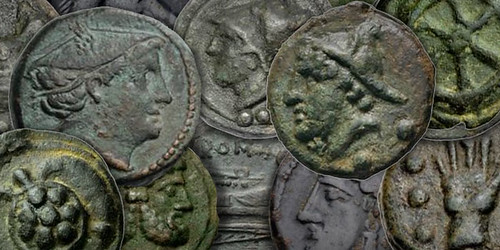
PREV ARTICLE
NEXT ARTICLE
FULL ISSUE
PREV FULL ISSUE
V25 2022 INDEX E-SYLUM ARCHIVE LOOSE CHANGE: MAY 29, 2022Here are some additional items in the media this week that may be of interest. -Editor CoinWeek has a nice article by Tyler Rossi on the Aes Grave. -Editor
It is said that when Greece was building grand temples of white marble, the Romans were living in mud huts. While this is a sweeping generalization, there is some truth behind it as is demonstrated by the Republic's earliest documented coinage, the Aes Rude or
By the early fourth century BCE, as the Roman economy evolved and local metalworking technology became more sophisticated, the Aes Rude slowly transformed into the Aes Grave or
To read the complete article, see:
Here are a couple of items for the bibliophiles among us. Trinity College Dublin has one of the world's greatest libraries, and the building is about to undergo a serious renovation. The photo is some real eye candy. Thanks to Harry Salyards for passing along this New York Times article. -Editor The Long Room, with its imposing oak ceiling and two levels of bookshelves laden with some of Ireland's most ancient and valuable volumes, is the oldest part of the library in Trinity College Dublin, in constant use since 1732. But that remarkable record is about to be disrupted, as engineers, architects and conservation experts embark on a 90 million euro ($97 million) program to restore and upgrade the college's Old Library building, of which the Long Room is the main part. The library, visited by as many as 1 million people a year, had been needing repairs for years, but the 2019 fire at Notre Dame cathedral in Paris was an urgent reminder that it needed to be protected, according to those involved in the conservation effort.
To read the complete article, see:
At The E-Sylum we love words as well as the books they come in. Here's an article with a great history of punctuation. Yes, even that had to be invented. While preparing this for tonight's issue I discovered that we'd actually referenced this exact essay a couple years ago. But here goes anyway. If you hadn't clicked the link to see the full article last time, here's another chance. -Editor
One of the primary purposes of writing in Ancient Greece and Rome was giving lectures and political speeches, not publishing texts. Before going on stage, an orator would work on his text, making subjective, individually determined signs for long and short syllables, pauses for rhetorical effect and breathing, and joining up of words when reading aloud. There was no such thing as reading at first sight. Writing without punctuation lasted for many hundreds of years, in spite of individual efforts such as those of Aristophanes, the librarian at Alexandria.
To read the complete article, see:
To read the earlier E-Sylum article, see:
Jeff Garrett published an article on the NGC site about gauging risk when purchasing coins. -Editor
In general, collectors should make an effort to assess their tolerance for risk when making an investment in rare coins. As with other investments, your timeline for investing is also extremely important. A stock advisor will ask if you are investing money that you might need sometime soon. Obviously, if you might need the funds in the near future, you should avoid risky investments that might drop sharply and will take years to recover. Investing in coins should also be for collectors who think long term.
To read the complete article, see:
Wayne Homren, Editor The Numismatic Bibliomania Society is a non-profit organization promoting numismatic literature. See our web site at coinbooks.org. To submit items for publication in The E-Sylum, write to the Editor at this address: whomren@gmail.com To subscribe go to: https://my.binhost.com/lists/listinfo/esylum All Rights Reserved. NBS Home Page Contact the NBS webmaster 
|



